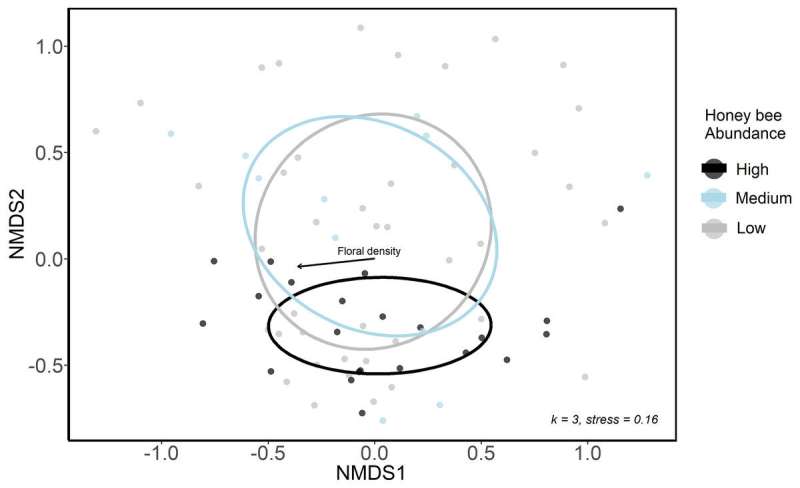This article has been reviewed according to Science X's editorial process and policies. Editors have highlighted the following attributes while ensuring the content's credibility:
fact-checked
peer-reviewed publication
trusted source
proofread
Abundance of urban honeybees adversely impacts wild bee populations, according to new research

Who hasn't received a pot of homegrown honey from a friend or relative who decided to take up urban beekeeping? The sentiment behind the gift is sweet, but their newfound interest in urban agriculture may be adversely affecting local biodiversity.
In a new paper in the journal PeerJ, a team led by Concordia researchers argue that the rapid growth in urban honeybee-keeping over the past decade may be negatively impacting nearby wild bee populations. Small bees with limited foraging ranges may be especially at risk, they write.
The researchers compared bee population data collected from sites around the island of Montreal in 2013 to data they collected at the same sites in the summer of 2020.
"We found that the sites with the largest increase in honeybee populations across sites and years also had the fewest wild bee species," says Gail MacInnis, a former Concordia postdoctoral researcher and the study's lead author. Etienne Normandin from the Université de Montréal and Carly Ziter, an assistant professor in the Department of Biology, are co-authors.
According to Quebec's Ministère de l'Agriculture, des Pêcheries et de l'Alimentation (Ministry of Agriculture, Fisheries and Food), the number of honeybee colonies on the island of Montreal has increased over twelvefold. In 2013, there were under 250 colonies. That number has ballooned to almost 3,000 in 2020.
Honeybees are not native to the region, the researchers note. This type of bee is therefore in competition with almost 180 other species for resources like pollen and nectar, as identified in the 2013 study.
Invasive and hungry
The researchers visited 15 sites across the island of Montreal that were known to attract pollinators. Sites included community gardens, cemeteries and large urban parks. The researchers used a standardized system of pan trap triplets—multicolored bowls designed to attract bees—and nets to collect their samples.
Each site was sampled five times between late June and early September 2020, with a total sample size of 6,200 bees. The researchers also measured other important factors that influence wild bee populations, like habitat and floral resource availability.
Nearly 4,000 samples turned out to be wild bees belonging to 120 species. Roughly 2,200 were honeybees. By contrast, in 2013, approximately 5,200 bees were collected at similar locations. Nearly all of these samples were wild bees belonging to 163 species.
Statistical analyses were performed across sites in 2020 on wild bee diversity; bee traits and honeybee abundance; wild bee community composition; and pollen depletion. Similar analyses compared the bee communities of 2013 and 2020.
The study found that wild bee species richness declined significantly. Honeybee abundance increased but remained similar to 2013 levels in areas where the honeybee population was comparatively lower. Honeybee abundance was also associated with pollen depletion in white clover flowers.
Not a risk-free hobby
MacInnis points out that a lack of registry or regulations makes studying bee populations difficult. Understanding honeybee colony density is crucial, she says, as just one honeybee colony can support up to 50,000 individuals.
"We need to provide food if we want to support large bee populations. But we also need to be careful about population density, especially for commercially managed bees, because they are prone to many diseases," she says. "This issue can become especially bad when there are many new beekeepers in the area. They may not be as knowledgeable about controlling for things like mites, viruses and other pathogens."
"Beekeeping provides an agricultural product that is valuable to people in the form of honey. My concern is that urban beekeeping is often falsely marketed as a solution to biodiversity loss," Ziter adds. "Just as we wouldn't advocate keeping backyard chickens to save the birds, we shouldn't look to beekeeping to save the bees. It's important that our actions match our goals or motivations."
"If our goal is to increase urban biodiversity, we're much better off planting pollinator gardens than adding more urban hives."
More information: Gail MacInnis et al, Decline in wild bee species richness associated with honey bee (Apis mellifera L.) abundance in an urban ecosystem, PeerJ (2023). DOI: 10.7717/peerj.14699
Journal information: PeerJ
Provided by Concordia University




















